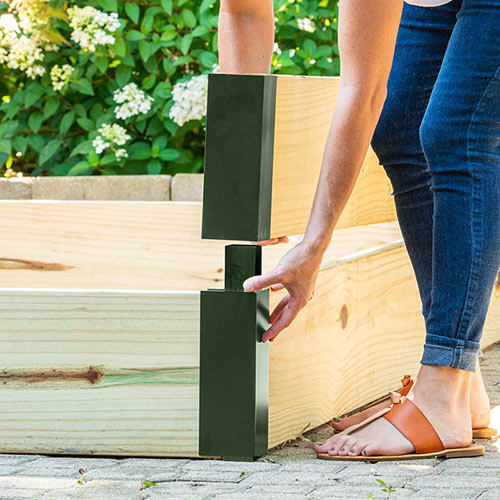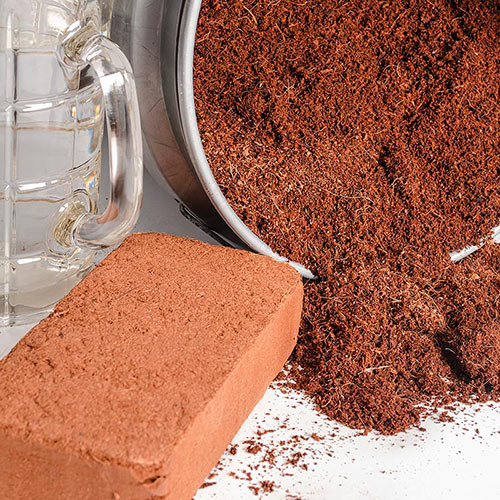Raised Bed Review; Plus Perlite vs. Vermiculite
-
Helpful Products from Gardens Alive!
-
 Raised Garden Bed Corners & Extenders
Raised Garden Bed Corners & Extenders -
 Coir Brick
Coir Brick
Q: I'm in the process of resizing a majority of our raised beds from four feet wide down to three feet. When finished we should wind up with beds ranging in size from four-by-three to eight-by-three. (Just waiting for the ground to warm up before I can start the work.) Now: You have mentioned adding perlite to the soil mix in previous articles on raised beds. What is the difference between perlite and vermiculite? Also: I usually mulch the beds with grass and leaves collected from the yard in the Fall. How much of either should be added to any of the beds?
--- Joseph in Warrenton PA
A: First, I want to commend Joseph on this project. The most important dimension when it comes to building raised beds is width. We always stress that you can make raised beds any LENGTH you want, but that they should never be more than four feet wide so that you can reach the center of the bed without stepping on the soil inside. One of the major benefits of raised beds is giving your plants light fluffy soil to grow in. If you walk on that soil, you might as well have a flat earth garden.
Whenever I give a talk on raised beds, I always point out that four feet is the maximum width; and that three feet wide is often better for children and people who don't have long arms. Less reaching is also better for your back, so three feet may be better for everyone.
So; firm raised bed rules:
• No wider than four feet and as long as you want.
• At least a foot higher than the surrounding soil;
• With walking lanes a minimum of two feet wide.
• Filled with high-quality compost, top soil and {ahem} something like perlite for improved drainage. No 'garden soil' of any kind.
• Preferably framed as opposed to mounded, with the ideal framing material being something like fieldstone or pavers that can be easily rearranged if your needs change—like Joseph who wants to reduce his width.
(As do many of us.)
Now: Perlite vs vermiculite. At last! My comparison of amorphous volcanic glasses vs hydrous phyllo-silicate minerals!
Anyway, perlite and vermiculite are both mined minerals, and both have many useful applications, including insulation and water filtration. In farming and gardening, they're used to both hold moisture and improve drainage in soils and soil-free mixes used for seed starting and container gardening. Vermiculite is flat and holds its water kind of like a sponge. Perlite is round and holds its water in little cavern-like structures. Both are approved for use in organic agriculture.
But I greatly prefer perlite. Why?
Partially it's a little bit like 'Jamison's vs Bushmills' in that it's the soil amendment I grew up with. There was a problem with asbestos contamination of some vermiculite years ago that seemed to make perlite the only safe choice, but I don't think that's still an issue.
I choose perlite—those cute little white balls that look like Styrofoam—mostly because it drains faster and better than vermiculite. If I gardened in a dry climate, I might choose spongy vermiculite; but in rainy Pennsylvania, I want something that gives up its water more easily.
(I'll add that both products can be a little dusty, especially when you get to the bottom of the bag, so be sure and wear a dust mask when you work with them.)
Now: I want to add that Joseph perhaps needs to wait a little longer that he plans to shorten the width of his beds. You can't work frozen soil, but you shouldn't work WET soil; it really degrades the long-term structure of your dirt. That's why I like the idea of building new beds in the fall, when there's often a better chance of the soil being dry. (It may be just as rainy, but the air temp is still warm enough to dry things out much more quickly than in the Spring.)
Now—let's touch on Joseph's leaves and grass clippings.
If chemical herbicides have been used, grass clippings should always stay on the lawn after mowing because treated clippings can kill any plants aren't lawn grass. And clippings should stay on the lawn when herbicides haven't been used, because those clippings are 10% nitrogen, which is the perfect lawn food. Now, about those leaves….
Shredded leaves make a great winter mulch for raised beds, preventing weeds and the loss of nutrients. Whole leaves, however, mat down like a tarp, preventing essential airflow to the soil and often causing serious mold problems.
And no matter what, mulches of any kind should never be tilled into raised beds. Tilling causes nutrient loss and weed woes. If the mulch is a good mulch, pull it aside to let the soil warm up, install your plants and then replace the mulch to prevent weeds.
--- Joseph in Warrenton PA
A: First, I want to commend Joseph on this project. The most important dimension when it comes to building raised beds is width. We always stress that you can make raised beds any LENGTH you want, but that they should never be more than four feet wide so that you can reach the center of the bed without stepping on the soil inside. One of the major benefits of raised beds is giving your plants light fluffy soil to grow in. If you walk on that soil, you might as well have a flat earth garden.
Whenever I give a talk on raised beds, I always point out that four feet is the maximum width; and that three feet wide is often better for children and people who don't have long arms. Less reaching is also better for your back, so three feet may be better for everyone.
So; firm raised bed rules:
• No wider than four feet and as long as you want.
• At least a foot higher than the surrounding soil;
• With walking lanes a minimum of two feet wide.
• Filled with high-quality compost, top soil and {ahem} something like perlite for improved drainage. No 'garden soil' of any kind.
• Preferably framed as opposed to mounded, with the ideal framing material being something like fieldstone or pavers that can be easily rearranged if your needs change—like Joseph who wants to reduce his width.
(As do many of us.)
Now: Perlite vs vermiculite. At last! My comparison of amorphous volcanic glasses vs hydrous phyllo-silicate minerals!
Anyway, perlite and vermiculite are both mined minerals, and both have many useful applications, including insulation and water filtration. In farming and gardening, they're used to both hold moisture and improve drainage in soils and soil-free mixes used for seed starting and container gardening. Vermiculite is flat and holds its water kind of like a sponge. Perlite is round and holds its water in little cavern-like structures. Both are approved for use in organic agriculture.
But I greatly prefer perlite. Why?
Partially it's a little bit like 'Jamison's vs Bushmills' in that it's the soil amendment I grew up with. There was a problem with asbestos contamination of some vermiculite years ago that seemed to make perlite the only safe choice, but I don't think that's still an issue.
I choose perlite—those cute little white balls that look like Styrofoam—mostly because it drains faster and better than vermiculite. If I gardened in a dry climate, I might choose spongy vermiculite; but in rainy Pennsylvania, I want something that gives up its water more easily.
(I'll add that both products can be a little dusty, especially when you get to the bottom of the bag, so be sure and wear a dust mask when you work with them.)
Now: I want to add that Joseph perhaps needs to wait a little longer that he plans to shorten the width of his beds. You can't work frozen soil, but you shouldn't work WET soil; it really degrades the long-term structure of your dirt. That's why I like the idea of building new beds in the fall, when there's often a better chance of the soil being dry. (It may be just as rainy, but the air temp is still warm enough to dry things out much more quickly than in the Spring.)
Now—let's touch on Joseph's leaves and grass clippings.
If chemical herbicides have been used, grass clippings should always stay on the lawn after mowing because treated clippings can kill any plants aren't lawn grass. And clippings should stay on the lawn when herbicides haven't been used, because those clippings are 10% nitrogen, which is the perfect lawn food. Now, about those leaves….
Shredded leaves make a great winter mulch for raised beds, preventing weeds and the loss of nutrients. Whole leaves, however, mat down like a tarp, preventing essential airflow to the soil and often causing serious mold problems.
And no matter what, mulches of any kind should never be tilled into raised beds. Tilling causes nutrient loss and weed woes. If the mulch is a good mulch, pull it aside to let the soil warm up, install your plants and then replace the mulch to prevent weeds.
-
Helpful Products from Gardens Alive!
-
 Raised Garden Bed Corners & Extenders
Raised Garden Bed Corners & Extenders -
 Coir Brick
Coir Brick







 Gardens Alive! & Supplies
Gardens Alive! & Supplies




